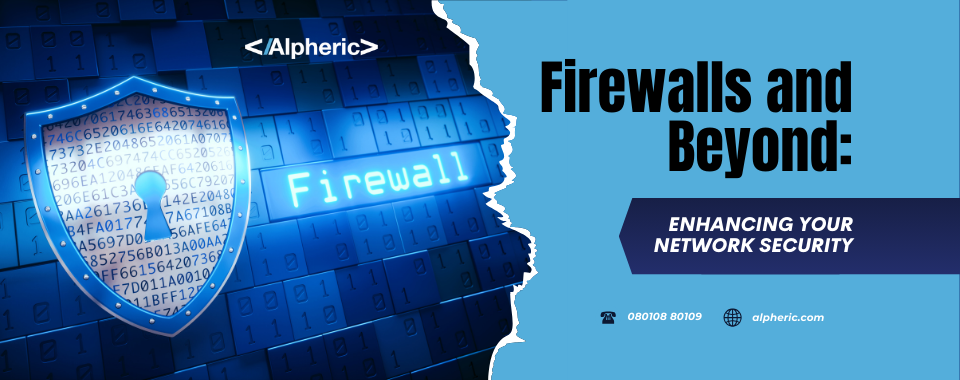
Introduction:
Begin with a compelling statement about the escalating cybersecurity threats in today’s world, emphasizing the importance of robust network security for businesses of all sizes. Briefly introduce the concept of firewalls as the first line of defense but hint at the need for advanced solutions to keep pace with modern threats.
Understanding Firewalls: The Foundation of Network Security
- What is a Firewall?
Explain the basic functionality of firewalls, describing how they act as barriers between trusted internal networks and untrusted external networks. Discuss the role of firewalls in monitoring and controlling traffic based on predefined security rules. - Types of Firewalls
Describe various types of firewalls: packet-filtering, proxy, stateful inspection, and next-generation firewalls (NGFW). Highlight how NGFWs are equipped with additional features, such as intrusion prevention, SSL inspection, and application control, that enhance security measures. - Common Firewall Configurations
Share insights on typical firewall setups, including perimeter firewalls, internal firewalls, and personal firewalls, emphasizing how each is tailored for different network environments and security needs.
The Limitations of Firewalls: Why They’re Not Enough Anymore
- Evolving Threat
Explain how firewalls alone may not defend against the latest sophisticated threats, such as ransomware, phishing, and zero-day attacks. Highlight the increasing frequency and complexity of cyber-attacks, which require more than a firewall’s basic filtering and monitoring capabilities. - Insider Threats and Internal Security Gaps
Discuss the challenges posed by insider threats, where employees or contractors inadvertently or maliciously compromise security. Emphasize that traditional firewalls primarily guard against external threats and are less effective in monitoring internal network activity. - Mobile and Remote Workforce Risks
Address how the rise of remote work and mobile access has complicated security management, making it essential for organizations to move beyond firewalls. Firewalls alone are insufficient in a hybrid work environment where employees connect from various locations and devices.
Advanced Security Solutions Beyond Firewalls
- Intrusion Detection and Prevention Systems (IDPS)
Describe IDPS solutions, which actively detect and respond to potential security threats by scanning network traffic in real-time. Mention how integrating IDPS with firewalls can provide a more comprehensive security posture. - Endpoint Detection and Response (EDR)
Introduce EDR as a powerful solution that monitors, detects, and mitigates security threats on end-user devices. Explain how EDR complements firewall security by securing devices that operate beyond the firewall’s reach. - Network Access Control (NAC)
Explain how NAC restricts unauthorized devices from accessing the network. This additional layer of security ensures that only authenticated users can access critical assets, helping mitigate risks from untrusted devices. - Zero Trust Architecture (ZTA)
Highlight the Zero Trust approach, which assumes that no user or device is trustworthy by default, even within the internal network. Describe how ZTA enforces strict identity verification and continuous monitoring, providing a security framework that’s robust against both external and internal threats.
The Role of AI and Machine Learning in Network Security
- AI-Driven Threat Detection
Explain how AI and machine learning are revolutionizing network security by identifying anomalies and potential threats based on behavior patterns. This proactive approach reduces response times and can detect threats that traditional firewalls might miss. - Automated Incident Response
Discuss how machine learning algorithms can help automate responses to specific incidents, ensuring quicker containment and reducing human error. Automated threat responses can work in tandem with firewalls to limit the spread of threats.
Securing a Hybrid Cloud Environment
- Cloud Firewalls and Cloud Security
Define cloud firewalls and their role in protecting cloud-based applications and services. Emphasize the need for cloud-native security practices as businesses increasingly rely on hybrid cloud environments for flexibility and scalability. - Data Encryption and VPNs
Highlight how data encryption and VPNs add a protective layer by securing data in transit, especially for remote users. Mention the importance of secure communication channels in preventing data breaches. - Identity and Access Management (IAM)
Briefly explain IAM, which controls user access to sensitive data based on user roles and permissions. IAM is particularly critical in hybrid environments where user access may vary depending on location, device, and role.
Practical Steps to Build a Multi-Layered Security Framework
- Developing a Comprehensive Security Policy
Encourage companies to establish a detailed security policy that includes guidelines for data access, password management, and remote work protocols. A security policy sets the groundwork for enforcing security measures across the organization. - Regular Security Training and Awareness
Emphasize the role of employee training in reducing insider threats. Encourage regular cybersecurity training sessions to educate employees about phishing tactics, password management, and safe browsing practices. - Routine Network Monitoring and Security Audits
Explain the importance of continuous network monitoring to detect unusual activities. Regular security audits help assess vulnerabilities and ensure all security protocols, including firewall settings, remain effective and up-to-date.
Looking Ahead: Future Trends in Network Security
- AI-Powered Autonomous Security Systems
Predict the growth of AI-powered autonomous security solutions, which can operate with minimal human intervention. Mention how these systems will evolve to adapt in real-time, helping organizations proactively combat advanced threats. - Quantum Computing’s Impact on Encryption
Briefly touch on the future role of quantum computing in cybersecurity. As quantum computing advances, encryption techniques will need to evolve to maintain secure communications. - Increased Focus on Privacy-Enhanced Computation (PEC)
Introduce the concept of PEC, which focuses on protecting data during processing. PEC could play a critical role in maintaining data security without compromising user privacy, becoming a valuable addition to network security frameworks.
Conclusion:
Wrap up by emphasizing that firewalls are a fundamental component of network security but that they’re not enough on their own in today’s complex threat landscape. Reinforce the need for a layered approach that combines firewalls with advanced security measures like AI-driven detection, Zero Trust Architecture, and continuous monitoring. Highlight Alpheric’s commitment to helping businesses stay ahead in cybersecurity through comprehensive solutions and forward-thinking strategies, and encourage readers to reach out for tailored network security consultations.
Follow us for more








